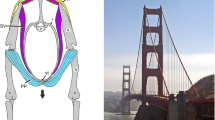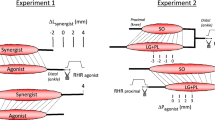Abstract
Locusts (Schistocerca gregaria) use a distinctive motor pattern to extend the tibia of a hind leg rapidly in a kick. The necessary force is generated by an almost isometric contraction of the extensor tibiae muscle restrained by the co-contraction of the flexor tibiae (co-contraction phase) and aided by the mechanics of the femoro-tibial joint. The stored energy is delivered suddenly when the flexor muscle is inhibited. This paper analyses the activity of motor neurons to the major hind leg muscles during kicking, and relates it to tibial movements and the resultant forces.
During the co-contraction phase flexor tibiae motor neurons are driven by apparently common sources of synaptic inputs to depolarized plateaus at which they spike. The two excitatory extensor motor neurons are also depolarized by similar patterns of synaptic inputs, but with the slow producing more spikes at higher frequencies than the fast. Trochanteral depressors spike at high frequency, the single levator tarsi at low frequency, and common inhibitors 2 and 3 spike sporadically. Trochanteral levators, depressor tarsi, and a retractor unguis motor neuron are hyperpolarized.
Before the tibia extends all flexor motor neurons are hyperpolarized simultaneously, two common inhibitors, and the levator trochanter and depressor tarsi motor neurons are depolarized. Later, but still before the tibial movement starts, the extensor tibiae and levator tarsi motor neurons are hyperpolarized. After the movement has started, the extensor motor neurons are hyperpolarized further and the depressor trochanteris motor neurons are also hyperpolarized, indicating a contribution of both central and sensory feedback pathways.
Variations in the duration of the co-contraction of almost twenty-fold, and in the number of spikes in the fast extensor tibiae motor neuron from 2–50 produce a spectrum of tibial extensions ranging from slow and weak, to rapid and powerful. Flexibility in the networks producing the motor pattern therefore results in a range of movements suited to the fluctuating requirements of the animal.
Similar content being viewed by others
References
Bennet-Clark HC (1975) The energetics of the jump of the locust Schistocerca gregaria. J Exp Biol 63: 53–83
Brown RHJ (1967) The mechanism of locust jumping. Nature (Lond), 214: 939
Burrows M, Watson AHD, Brunn DE (1989) Physiological and ultrastructural characterization of a central synaptic connection between identified motor neurones in the locust. Eur J Neurosci 1: 111–126
Godden DH (1975) The neural basis for locust jumping. Comp Biochem Physiol 51A: 351–360
Gynther IC, Pearson KG (1986) Intracellular recordings from interneurones and motoneurones during bilateral kicks in the locust: implications for mechanisms controlling the jump. J Exp Biol 122: 323–343
Gynther IC, Pearson KG (1989) An evaluation of the role of identified interneurons in triggering kicks and jumps in the locust. J Neurophysiol 61: 45–57
Hale JP, Burrows M (1985) Innervation patterns of inhibitory motor neurones in the thorax of the locust. J Exp Biol 117: 401–413
Heitler WJ (1974) The locust jump. Specialisations of the metathoracic femoral-tibial joint. J Comp Physiol 89: 93–104
Heitler WJ, Bräunig P (1988) The role of fast extensor motor activity in the locust kick reconsidered. J Exp Biol 136: 289–309
Heitler WJ, Burrows M (1977a) The locust jump. I. The motor programme. J Exp Biol 66: 203–219
Heitler WJ, Burrows M (1977b) The locust jump. II. Neural circuits of the motor programme. J Exp Biol 66:P 221–241
Hoyle G, Burrows M (1973) Neural mechanisms underlying behavior in the locust Schistocerca gregaria. I Physiology of identified motorneurons in the metathoracic ganglion. J Neurobiol 4: 3–41
Matheson T, Field LH (1995) A tension receptor of a specialised muscle in the metathoracic leg of the locust. J Exp Biol (in press)
Miall RC, Hereward CJ (1988) A simple miniature capacitative position transducer. J Exp Biol 138: 541–544
Pearson KG, Robertson RM (1981) Interneurons coactivating hindleg flexor and extensor motoneurons in the locust. J Comp Physiol 144: 391–400
Pearson KG, Heitler WJ, Steeves JD (1980) Triggering of locust jump by multimodal inhibitory interneurons. J Neurophysiol 43: 257–278
Pflüger H-J, Burrows M (1978) Locusts use the same basic motor pattern in swimming as in jumping and kicking. J Exp Biol 75: 81–93
Phillips CE (1980) An arthropod muscle innervated by nine excitatory motor neurons. J Exp Biol 88: 249–258
Sandeman DC (1968) A sensitive position measuring device for biological systems. Comp Biochem Physiol 24: 635–638
Steeves JD, Pearson KG (1982) Proprioceptive gating of inhibitory pathways to hindleg flexor motoneurons in the locust. J Comp Physiol 146: 507–515
Theophilidis G, Burns MD (1979) A muscle tension receptor in the locusl leg. J Comp Physiol 131: 247–254
Wilson JA, Hoyle G (1978) Serially homologous neurones as concomitants of functional specialisalion. Nalure 274: 377–379
Author information
Authors and Affiliations
Rights and permissions
About this article
Cite this article
Burrows, M. Motor patterns during kicking movements in the locust. J Comp Physiol A 176, 289–305 (1995). https://doi.org/10.1007/BF00219055
Accepted:
Issue Date:
DOI: https://doi.org/10.1007/BF00219055




